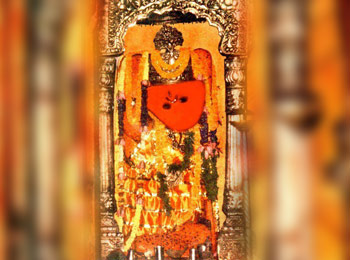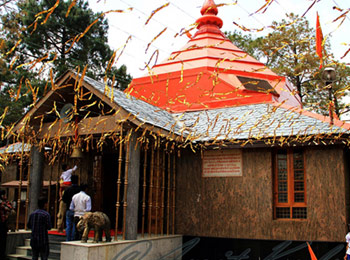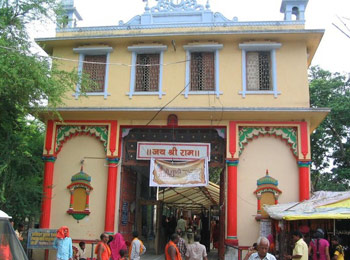- Hanuman
Sankat Mochan Hanuman Temple
- Varanasi,Uttar Pradesh
- View on map
- Tell us about this temple
Overview
The Sankat Mochan Hanuman Temple is one of the sacred temples of Hanuman in the city of Varanasi, Uttar Pradesh, India. The original name of present city Varanasi was 'Kashi,' derived from the word 'Kasha,' meaning brightness. As one of the oldest city, history of Kashi dates back to Aryans civilization with Varanasi being the nucleus of Aryan religion and philosophy. The city has got 3500 years of recorded history. Varanasi is a renowned center for silk weaving and brassware. It is situated by the Assi river on near to the Durga and the New Vishwanath temple within the Banaras Hindu University campus. Sankat Mochan in Hindi means reliever from troubles.The current temple structure was built in early 1900s by the educationist and freedom fighter, Pandit Madan Mohan Malviya, the founder of Banaras Hindu University. In the early phase of its establishment, it was a very small temple. In due course of time, the Mahants collected and donated funds to upgrade the structure. Presently it is fairly big.
About the Temple

The temple has undergone many repairs throughout its life. Ever since under the rule of Lalitaditya, repairs were undertaken by Zain-ul-Abideen after the temple got damaged in an earthquake. The repairs were also carried out during the Governorship of Sheikh Mohi-ud-Din. Maharaja Gulab Singh, a Dogra ruler, is credited for the stone steps that form a part of the passage to the shrine. In 1925, the electrification of the temple was done.
About the Deity

Lord Hanuman is very powerful avatar of the Lord Shiva and known as the Rudra avatar. He is the son of the Lord of wind (Pavan) and Mata Anjana Devi, that’s why He is known as the Pavanputra. It is considered as, the Lord Hanuman become very happy with the very little prayer and Pooja. Lord Hanuman is the great Karma Yogi and an extraordinary Brahmachari. He is the sign of being without any desire and unselfish Bhakti towards the Lord Rama. Lord Hanuman is immortal. He is also the symbol of courage, power and winner with the never-ending Bhakti for Lord Rama, Lakshman and Sita Devi in his soul. Lord Hanuman was the living embodiment for the power of Ram-Nam. Even Lord Rama said that all will honour and worship you like myself Lord Hanuman is also known as the Mahavira, Pavanputra, Bajrangabali, Pavankumar and others. This temple has the unique distinction of having Lord Hanuman facing his Lord, Rama, whom he worshiped with steadfast and selfless devotion.
Legend and Stories
Legend has it that the temple has been built on the very spot where Tulsidas had a vision of Hanuman. Sankat Mochan Temple was founded by Tulsidas who was the author of the Ramacharitamanasa, which is the Awadhi version of the Sanskrit epic Ramayana originally written by Valmiki. Tradition promises that regular visitors to the temple will gain the special favor of Lord Hanuman. The Sankat Mochan Foundation (SMF) was established in 1982 by Veer Bhadra Mishra, the Mahant (High priest) of the temple, and has been working for cleaning and protecting the Ganges River. Its projects are funded in part by aid from the U. S. and Swedish governments. Mishra was formerly Head of the Civil Engineering Department at the Indian Institute of Technology Varanasi IIT(BHU) and was awarded United Nations Environment Programme (UNEP) established the "Global 500 Roll of Honour" in 1992,and later the TIME magazine's "Hero of the Planet" award in 1999.
The foundation has been working with Australia-based environmental group, Oz Greene, under a programme called “Swatcha Ganga Abhiyan” for over 25 years. It celebrated its silver jubilee on 3–4 November 2007, with two-day event which concluded at the Tulsi Ghat, on the Ganges. On 7 March 2006, one of three explosions hit the temple while the aarti was in progress in which numerous worshippers and wedding attendees were participating. The crowd helped each other in the rescue operation after the explosion. The next day a large number of devotees resumed their worship as usual.
On March 7, 2006, one of three explosions hit the temple while the aarti was in progress in which numerous worshippers and wedding guests had participated. The crowd helped each other in the rescue operation after the explosion. The next day a large number of devotees resumed their worship as usual. The temple still continues to be attended by thousands of Rama and Hanuman devotees who chant Hanuman Chalisa and Sundarkand (also provided in the form of a booklet in the temple for free). After the terrorist incident of 2007, a permanent police post was set up inside the temple. Sankat Mochan temple is near the Banaras Hindu University.
Festival
On the day of Kartik Krishna Chaturdashi, special prayers are made to the Lord. The temple observes an annual festival on the full moon night of the month of 'Chaitra', which is also known as Hanuman Jayanti. At this juncture, a procession starting from Durgakund adjacent to the historic Durga Temple to Sankat Mochan, is carried out. The festival too, attracts plenty of visitors to Sankat Mochan Temple. Classical Indian music and drama performances are carried on all night and into the following morning. Maestros from all around India usually play for free for this special occasion. Programs are organized over 5 days and are rehearsed extensively by the performers during the year leading up to the event.
The temple is also known to have the most monkeys of any shrine in the city so don’t be alarmed if the patron next to you is not entirely human. Each year in the month of April, the temple organizes a classic music and dance concert festival titled the Sankat Mochan Sangeet Samaroh in which musicians and performers from all over India take part. The first festival was organized 88 years ago, and since then it attracts numerous stalwarts of Indian classical music and dance world, including Odissi guru, Kelucharan Mahapatra, who was associated since its early days. In fact he was instrumental in starting women's participation in the festival with Sanjukta Panigrahi, Swapna Sundari and Kankana Banerjee. In 2009, the six-day concert saw over 35 artists including, vocalist Pandit Jasraj and Kathak exponent Pandit Birju Maharaj. The 2010 concert was spread over five days, during which artists like, Pandit Jasraj, Sunanda Patnayak, Pt. Channulal Mishra, Pt. Rajan-Sajan Mishra and Pt. Amar Nath Mishra performed. In 2015 concert famous Pakistani-ghazal singer Ustad Ghulam Ali performed at Sankat Mochan Sangeet Samaroh.
Poojas Offered
The Pratah Arati or the one which is called the dawn offering is carried on every morning at 5 am. There is also a Sandhya Arati in the evening offering at around 8:30pm. Evening at 10 pm the Rathri Arati is carried on and then the gates are closed. On Tuesdays and Saturdays, ceremonies are held. In this ceremony Akant Nama Sangeerthanam of Lord Hanumana especially Kishkindha and Sundera Kand are recited. Even special prayers are held during the dawn of Kartik Krishna Chathurdhashi. To provide solace to the disturbed souls in the universe various discourses based on Ramayana are carried out.
- Ukshakala Pooja-02:30 AM - 03:00 AM
- Kala santhi Pooja-03:30 AM - 04:00 AM
- Uchikala Pooja-04:00 AM - 04:15 AM
- Sayaratchai Pooja-04:00 AM - 04:30 AM
- Irandam Kala Pooja-06:30 AM - 07:00 AM
- Arthajama Pooja-07:00 PM - 07:30 PM
Temple Timings
The Sankat Mochan Temple opens at 5:00 am in the morning and closed at 10:00 pm in the night.
Offerings
In the temple, offerings to Lord Hanuman (called Prasad) are sold like the special sweet, besan ladoos, which the devotees relish; the idol is also decked with a pleasant marigold flower garland as well. People place Sindoor on the Lord and offer laddoos. The Sindoor from the statue of Lord Hanuman is given as offering to the devotees.
Facilities available
1. Food available for purchase
2. Bathroom facilities
3. Camera/Video allowed
4. Wearing of shoes/footwear allowed
5. Lockers/Storage
Best time to visit
Around whole year.
Visit Duration
1-2hrs.
Entry Fee
No entry fee.
Rare Facts
This temple has the unique distinction of having Lord Hanuman facing his Lord, Rama, whom he worshiped with steadfast and selfless devotion.
Significance
The common belief among millions of people in India and Indians abroad is that if devotees visit this holy Sankat Mochan Hanuman Temple and offer Holy Pooja regularly, then their wishes and desires get fulfilled and get the relief from all types of Sankat i.e. obstacles and hindrances on the way of progress, prosperity or day-to-day life. At the temple every Tuesday and Saturday thousands of people stands in huge queue in front of temple to offer prayer to Lord Hanuman. As per the Vedic Astrology, Hanuman saves and rescues human being from the evil effect of planet Saturn and even from the odd events in ones' life. People having ill -placed Saturn in their particular horoscope should offer Pooja or visit to this holy Sankat Mochan Hanuman Temple to get to know about the astrological remedy and to remove their distress.
The word "Sankat Mochan” is the meaning of divine that helps in removing sufferings i. e. Lord Hanuman. Devotees put "Sindoor" on the statue of Lord Hanuman and even offer "laddoos" as prasad. The "Sindoor", of the statue of Lord Hanuman is put on the foreheads of devotees as scared tilak. Devotees visiting here recite hymns of "Hanuman Chalisa ", "Kishkindha" and "Sundar Kand" as a due part of their prayers. In the earlier times, the temple was very small in its size. Later, the temple’s complex was more extended attributable to the kind donations made by the devotees.
Before / While visiting the temple
Tourists have to go through an intense security check. During the visit to the sacred place, no intoxication should be practiced. No Cigarette smoking, No Alcohol, and No tobacco. Tourists are not allowed to take eatables in temple premises. While in the sacred structure, pets are not allowed. Beware and stay careful with the monkeys that dwell in large number inside and outside temple complex.
Other places to Visit
Annapurna Temple
The Annapurna Temple is very much near to the Kashi Vishwanath temple. This is a very much sacred temple of Devi Annapurna, believed as the "Goddess of Food".
Mritunjay Mahadev Temple
Mritunjay Mahadev Temple lies on the route of Daranagar to Kalbhairav temple. This temple is dedicated to Lord Shiva. Just besides Mritunjay temple there is a well of much religious importance and purity , whose water is said to be mixture of several underground streams and good for eliminating several diseases.
Kalbhairav Temple
Kalbhairav Temple is a very ancient temple of Varanasi near by the Head Post Office, VishesharGanj. God KalBhairav is believed to be the “Catwalk of Varanasi", and is believed that without his permission no one can stay in Kashi.
Sankatha Temple
Sankatha Temple is the important temple dedicated to “Godess of Remedy” near the Sindhia Ghat of Devi Sankatha. Inside the temple premises there exists a huge statue of a Lion. Also there are even nine temples of nine planets nearby to this Sankata temple.
Bharat Mata Temple
In the year 1936, the Bharat Mata Temple was inaugurated by Mahatma Gandhi and embibes one perfect relief maps of India carved out of marble. The Temple was gifted through the nationalists Babu Shiv Prasad Gupta (Barat Ratana) and Shri Durga Prasad Khatri, leading numismatists and antiquarians. There are good accommodation facilities near the temple for the devotees to rest and stay. It provides every possible facility for the devotees.
Accessibility
Airport
Flights are easily available and serve as the quickest and comfortable way to get to Varanasi city. As the city is well- connected by regular service of flights with some major cities like Delhi, Mumbai (Bombay), Kolkata (Calcutta), Bhubaneswar, Lucknow, Jaipur, Khajuraho, Katmandu. The Airport at Babatpur is just 22 kilometer away from the city.
Railways
One can get to Varanasi city as it is connected by super-fast trains to Delhi and even all the major cities across the country like Mumbai, Kolkata, Chennai, Lucknow, Allahabad, Patna, Jaipur, Gorakhpur and Khajuraho.
Rajdhani Exp ( Hawrah - Mughal Sarai - New Delhi)
Toofan Exp ( Howrah - Mughal Sarai - Delhi)
North East Superfast Exp ( Delhi - Mughal Sarai Guwahati)
Magadh Exp ( Delhi - Mughal Sarai Patna)
Mahanagari Exp ( Varanasi - Mumbai )
Pawan Exp ( Varanasi - Mumbai )
Sabarmati Exp ( Varanasi - Ahmedabad)
Ganga Kaveri Exp ( Varanasi - Chennai)
Poorwa Exp (Howrah - Varanasi - Delhi) Himgiri Exp (Jammu - Varanasi - Howrah)
Sealdah Exp (Varanasi - Jammu Tawi).
Road
The other means of reaching Varanasi is by road and a good network of roads connects to all major towns of Uttar Pradesh and other neighboring areas. Regular bus services can be availed from Varanasi to Jaunpur, Allahabad, Lucknow, Faizabad and Gorakhpur. One can also go to all the major cities by road. People visiting the temple may come at Varanasi and hire a cab, auto or a rickshaw to visit the temple. It remains open throughout the year.
Temple Address
Sankat Mochan Hanuman Temple,
Sankat Mochan Road, Saket Nagar, Nagwa Lanka,
Varanasi, Uttar Pradesh 221005, India.
Significance
Devotees visit this temple to seek fulfillment of the following:-
- To get relief from ill effects of Mars and Saturn Planet
Shlokas
Anjana Nandanam Veeram Janaki Soka Naasanam, Kapeesa Maksha Hantharam, Vandhe Lanka Bhayankaram
Meaning -We salute Lanka's horror, Anjana's brave son, who ended Sita's sorrows, the ruler of monkeys and the one who killed Aksha, Ravana's son.
Raamaaya Ramabadraaya Ramachandraaya Vaydasey Raghunaadaaya Naadaaya Seethaaya Pathaye Namo Namah
Meaning -I offer salutations to Sri Rama, the one who safeguards all, who knows all, who has descended from the Raghu dynasty, Sita's spouse and the Lord of the universe.
Mano Javam , Maruda Thulya Vegam, Jithendriyam Buddhi Matham Varishtam, Vatha Atmajam Vanara Yudha Mukhyam, Sree Rama Dootham Sirasa Namami
Meaning -I bow my head to salute Rama's messenger, who has won over His mind, who is as fast as the wind, who has mastered his organs, who is the most knowledgeable, who is the wind God's son, and who leads as the chief in the army of monkeys.
Anjaneya Madhi Paatalaananam, Kanjanaadri Kamaneeya Vigraham, Paarijatha Tharu Moola Vaasinam, Bhaavayami Bhava mana Nandanam
Meaning -I bow before the wind God's darling son, Anjana's son, the great killer of ogres, who is handsome and like a golden mountain, who lives near Parijatha tree's roots.
Timings
5:00 am to 10:00 pm
